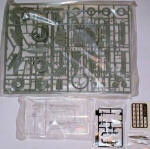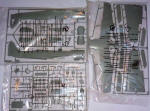
Trumpeter 1/24 FW-190D-9
| KIT #: | 02411 |
| PRICE: | $expensive |
| DECALS: | Two options |
| REVIEWER: | Francisco Santoro |
| NOTES: | Includes resin parts. |

| HISTORY |
With the D version the power plant was changed from the radial engine of earlier models to a 12-cylinder inverted-Vee liquid-cooled engine. The Jumo 213A generated 1,750 PS (1,726 hp, 1,287 kW), and could produce 2,100 PS (2,071 hp, 1,545 kW) of emergency power with MW 50 injection, improving performance to 426 mph (686 km/h) at 21,650 ft (6,600 m). In order to fit the new engine in the Fw 190 fuselage while maintaining proper balance, both the nose and the tail of the aircraft were lengthened, adding nearly 1.52 m (4.99 ft) to the fuselage, bringing the overall length to 10.192 m (33.438 ft) versus the 9.10 m (29.9 ft) of the late war A-9 series. The lengthened tail required a straight-sided bay, 30 cm (12 in) long, spliced in forward of the rear angled joint and tail assembly of the fuselage. To further aid balance, the pilot's oxygen bottles were moved aft and located in the new bay. This gave the rear fuselage a "stretched" appearance.
| THE KIT |
 Trumpeter is, for now, the only
manufacturer to have produced the Fw 190D-9
in this scale. Produced from 2004 onw
Trumpeter is, for now, the only
manufacturer to have produced the Fw 190D-9
in this scale. Produced from 2004 onw ards, the model shows an state of
the art moulding technology, having rivets which can be covered by filling them,
to those who donŽt want them, and consistent panel lines.
ards, the model shows an state of
the art moulding technology, having rivets which can be covered by filling them,
to those who donŽt want them, and consistent panel lines.
As is standard from Trumpeter, this is what they give you:
1) A complete Junkers Jumo 213 engine.
2) Positionable ailerons.
3) Positionable flaps.
4) Movable rudder.
5) Springs for the landing gear, giving the plane a "loaded" appearance when finished.
6) A total length of 42,5 cm and a wingspan of 43,7 cm.
7) Open or closed option for the engine cowling.
8) A full cockpit.
9) An acetate film to help you recreate the control panel (youŽll have to paint the plastic part first).
10) Option to have an early or late canopie style (the early one has a continuous opaque line, the blown one has the line until the middle of it).
11) A separate wheel assembly , which makes for an easy painting.
12) Deviating from their 1:32 line of aircraft, this one doesnŽt have photoetch for the cockpit.
13) Fuel tank.
14) Half printed Swastikas.
 Trumpeter gives the modeller two
painting options:
Trumpeter gives the modeller two
painting options:
1) Focke Wulf Fw 190 Yellow 11, II/JG 2, Stockheim, Germany, 1945. Painted in RLM 75/76/82. The yellow/white band shows that the aircraft of JG 2 were used in the Defense of the Reich.
2) Focke Wulf Fw 190D-9 Black 12, KG(J)/27. Painted in RLM 75/76/82. The checkered green/white band shows that the aircraft of KG(J)27 were used in the Defense of the Reich.
| CONCLUSIONS |
IŽm sure that this model will be a very easy model to build and, because the aircraft is so popular among modelers, plenty of them will be made using the 1:24th aftermarket decals. Those that are for the Papagei Staffel of JV 44 by EagleCals would sure look nice.
| REFERENCES |
https://en.wikipedia.org/wiki/List_of_Focke-Wulf_Fw_190_variants#Fw_190D-9
August 2015
If you would like your product reviewed fairly and fairly quickly, please contact the editor or see other details in the Note to Contributors.